An Exploratory Study on Determining and Modeling the Creep Behavior of an Acrylic Pressure-Sensitive Adhesive
Abstract
:1. Introduction
2. Experimental Details
2.1. Materials
2.2. Specimen Manufacturing
2.2.1. Bulk Specimens
2.2.2. SLJ Specimens
2.3. Testing Setup
2.3.1. Bulk Tensile Testing
2.3.2. Quasi-Static Testing
2.3.3. Static Creep Testing
2.3.4. Cyclic Creep Testing
2.4. DIC Analysis
3. Analytical Creep Model
Cyclic Creep Model
4. Results and Discussion
4.1. Bulk Tensile and Quasi-Static Tests
4.2. Static Creep
4.3. Cyclic Creep
5. Conclusions
- The static creep results are in line with what was expected, that is, the smaller the load, the higher the rupture time;
- For the 60% and 80% load levels, the stable secondary creep phase is not very prominent, and there is a more pronounced presence of the higher strain rate phases;
- For the case of the 30% load level, the tests lasted more than 50 times longer than the other load levels, with a very pronounced stable phase corresponding to the secondary creep phase. This behavior is in accordance with a more favorable stress state with less load level, presenting a slower progression of strains;
- The creep strain rate model proved to be able to correctly characterize the creep behavior of the various load levels tested;
- Although some details of the experimental curves may be more difficult to fully match, all three phases of the curve have been satisfactorily modeled, with a special focus on the third phase, which is rarely modeled in the literature;
- Preliminary results for cyclic creep tests showed good agreement when the maximum strains of each cycle are used to model the cyclic creep phenomenon. As presented, the curves have the three phases well defined, in almost total agreement with maximum strains determined experimentally.
Author Contributions
Funding
Institutional Review Board Statement
Informed Consent Statement
Data Availability Statement
Acknowledgments
Conflicts of Interest
References
- Deshpande, A.; Song, Z.; Vaidya, S. A Creep Model For Pressure Sensitive Adhesives under Shear Load. In Proceedings of the 2020 Asia-Pacific International Symposium on Advanced Reliability and Maintenance Modeling (APARM), Vancouver, BC, Canada, 20–23 August 2020; pp. 1–5. [Google Scholar] [CrossRef]
- Baek, S.-S.; Hwang, S.-H. Eco-friendly UV-curable pressure sensitive adhesives containing acryloyl derivatives of monosaccharides and their adhesive performances. Int. J. Adhes. Adhes. 2016, 70, 110–116. [Google Scholar] [CrossRef]
- Huang, H.; Jiang, Q.; Dasgupta, A.; Mirbagheri, E.; Darbha, K. Creep Response of Assemblies Bonded with Pressure Sensitive Adhesive (PSA). In Proceedings of the InterPACK2018, ASME 2018 International Technical Conference and Exhibition on Packaging and Integration of Electronic and Photonic Microsystems, San Francisco, CA, USA, 27–30 August 2018. [Google Scholar] [CrossRef]
- Seok, W.C.; Leem, J.T.; Song, H.J. Acrylic pressure-sensitive adhesives based on ethylene glycol acrylate for flexible display application: Highly elastic and recoverable properties. Polym. Test. 2022, 108, 107491. [Google Scholar] [CrossRef]
- Silva, L.F.M.; Öchsner, A.; Adams, R. Handbook of Adhesion Technology; Springer: Berlin/Heidelberg, Germany, 2018. [Google Scholar] [CrossRef]
- Deng, X. Progress on rubber-based pressure-sensitive adhesives. J. Adhes. 2016, 94, 77–96. [Google Scholar] [CrossRef]
- Baek, S.-S.; Jang, S.-J.; Hwang, S.-H. Preparation and adhesion performance of transparent acrylic pressure sensitive adhesives: Effects of substituent structure of acrylate monomer. Int. J. Adhes. Adhes. 2016, 64, 72–77. [Google Scholar] [CrossRef]
- Park, K.H.; Lee, D.Y.; Yoon, S.H.; Kim, S.H.; Han, M.S.; Jeon, S.; Kim, Y.; Lim, Y.K.; Hwang, D.-H.; Jung, S.-H.; et al. Adhesion Improvement of Solvent-Free Pressure-Sensitive Adhesives by Semi-IPN Using Polyurethanes and Acrylic Polymers. Polymers 2022, 14, 3963. [Google Scholar] [CrossRef] [PubMed]
- Antosik, A.K.; Mozelewska, K.; Piątek-Hnat, M.; Czech, Z.; Bartkowiak, M. Silicone pressure-sensitive adhesives with increased thermal resistance. J. Therm. Anal. Calorim. 2021, 147, 7719–7727. [Google Scholar] [CrossRef]
- Márquez, I.; Paredes, N.; Alarcia, F.; Velasco, J.I. Influence of polymerizable surfactants on the adhesion performance and water resistance of water-based acrylic pressure-sensitive adhesives (PSAs). J. Adhes. Sci. Technol. 2022, 1–19. [Google Scholar] [CrossRef]
- Fuensanta, M.; Martín-Martínez, J.M. Structural and Viscoelastic Properties of Thermoplastic Polyurethanes Containing Mixed Soft Segments with Potential Application as Pressure Sensitive Adhesives. Polymers 2021, 13, 3097. [Google Scholar] [CrossRef]
- Seok, W.C.; Park, J.H.; Song, H.J. Effect of silane acrylate on the surface properties, adhesive performance, and rheological behavior of acrylic pressure sensitive adhesives for flexible displays. J. Ind. Eng. Chem. 2022, 111, 98–110. [Google Scholar] [CrossRef]
- Lee, J.-H.; Shim, G.-S.; Park, J.-W.; Kim, H.-J.; Kim, Y. Adhesion performance and recovery of acrylic pressure-sensitive adhesives thermally crosslinked with styrene–isoprene–styrene elastomer blends for flexible display applications. J. Ind. Eng. Chem. 2019, 78, 461–467. [Google Scholar] [CrossRef]
- Lee, J.H.; Park, J.; Myung, M.H.; Baek, M.-J.; Kim, H.-S.; Lee, D.W. Stretchable and recoverable acrylate-based pressure sensitive adhesives with high adhesion performance, optical clarity, and metal corrosion resistance. Chem. Eng. J. 2020, 406, 126800. [Google Scholar] [CrossRef]
- Khoramishad, H.; Ashofteh, R.S. Influence of multi-walled carbon nanotubes on creep behavior of adhesively bonded joints subjected to elevated temperatures. J. Adhes. 2018, 95, 979–994. [Google Scholar] [CrossRef]
- Tan, W.; Na, J.-X.; Zhou, Z.-F. Effect of temperature and humidity on the creep and aging behavior of adhesive joints under static loads. J. Adhes. 2022, 99, 672–690. [Google Scholar] [CrossRef]
- Houshyar, S.; Shanks, R.; Hodzic, A. Tensile creep behaviour of polypropylene fibre reinforced polypropylene composites. Polym. Test. 2005, 24, 257–264. [Google Scholar] [CrossRef]
- Wang, W.-H.; Huang, H.-B.; Du, H.-H.; Wang, H. Effects of fiber size on short-term creep behavior of wood fiber/HDPE composites. Polym. Eng. Sci. 2014, 55, 693–700. [Google Scholar] [CrossRef]
- Khabazaghdam, A.; Behjat, B.; Yazdani, M.; Da Silva, L.F.M.; Marques, E.A.S.; Shang, X. Creep behaviour of a graphene-reinforced epoxy adhesively bonded joint: Experimental and numerical investigation. J. Adhes. 2020, 97, 1189–1210. [Google Scholar] [CrossRef]
- Ortega-Iguña, M.; Chludzinski, M.; Sánchez-Amaya, J.M. Comparative Mechanical Study of Pressure Sensitive Adhesives over Aluminium Substrates for Industrial Applications. Polymers 2022, 14, 4783. [Google Scholar] [CrossRef]
- Eveloy, V.; Rodgers, P.; Pecht, M. Reliability of Pressure-Sensitive Adhesive Tapes for Heat Sink Attachment in Air-Cooled Electronic Assemblies. IEEE Trans. Device Mater. Reliab. 2004, 4, 650–657. [Google Scholar] [CrossRef]
- Townsend, B.W.; Ohanehi, D.C.; Dillard, D.; Austin, S.R.; Salmon, F.; Gagnon, D.R. Characterizing acrylic foam pressure sensitive adhesive tapes for structural glazing applications—Part II: Creep rupture results. Int. J. Adhes. Adhes. 2011, 31, 650–659. [Google Scholar] [CrossRef]
- Duan, X.; Yuan, H.; Tang, W.; He, J.; Guan, X. A Phenomenological Primary–Secondary–Tertiary Creep Model for Polymer-Bonded Composite Materials. Polymers 2021, 13, 2353. [Google Scholar] [CrossRef]
- Wu, C.; Wu, R.; Xia, W.; Tam, L. Understanding Creep Behavior of Semicrystalline Polymer via Coarse-Grained Modeling. J. Polym. Sci. Part B Polym. Phys. 2019, 57, 1779–1791. [Google Scholar] [CrossRef]
- Sadigh, M.S.; Paygozar, B.; da Silva, L.; Martínez-Pañeda, E. Creep behaviour and tensile response of adhesively bonded polyethylene joints: Single-Lap and Double-Strap. Int. J. Adhes. Adhes. 2020, 102, 102666. [Google Scholar] [CrossRef]
- Boumakis, I.; Ninčević, K.; Vorel, J.; Wan-Wendner, R. Creep rate based time-to-failure prediction of adhesive anchor systems under sustained load. Compos. Part B Eng. 2019, 178, 107389. [Google Scholar] [CrossRef] [Green Version]
- Geiss, P.; Vogt, D. Durability of Pressure Sensitive Adhesive Joints; Kaiserslautern University of Technology: Kaiserslautern, Germany, 2007. [Google Scholar]
- Ernault, E.; Diani, J.; Schmid, Q. Single-lap joint creep behaviour of two soft adhesives. J. Adhes. 2022, 1–17. [Google Scholar] [CrossRef]
- Reis, P.N.B.; Pereira, A.M.; Ferreira, J.A.M.; Costa, J.D.M. Cyclic creep response of adhesively bonded steel lap joints. J. Adhes. 2016, 93, 704–715. [Google Scholar] [CrossRef]
- Li, X.; Qi, C.; Zhang, P. A micro-macro confined compressive fatigue creep failure model in brittle solids. Int. J. Fatigue 2019, 130, 105278. [Google Scholar] [CrossRef]
- Launay, A.; Marco, Y.; Maitournam, M.; Raoult, I.; Szmytka, F. Cyclic behavior of short glass fiber reinforced polyamide for fatigue life prediction of automotive components. Procedia Eng. 2010, 2, 901–910. [Google Scholar] [CrossRef]
- Sarkar, A.; Nagesha, A.; Parameswaran, P.; Sandhya, R.; Laha, K. Insights into dynamic strain aging under cyclic creep with reference to strain burst: Some new observations and mechanisms. Part-1: Mechanistic aspects. Mater. Sci. Eng. A 2016, 660, 213–224. [Google Scholar] [CrossRef]
- Liu, L.; Wang, X.; Wu, Z.; Keller, T. Tension-tension fatigue behavior of ductile adhesively-bonded FRP joints. Compos. Struct. 2021, 268, 113925. [Google Scholar] [CrossRef]
- Taleb, L.; Cailletaud, G. Cyclic accumulation of the inelastic strain in the 304L SS under stress control at room temperature: Ratcheting or creep? Int. J. Plast. 2011, 27, 1936–1958. [Google Scholar] [CrossRef]
- Gomatam, R.R.; Sancaktar, E. Effects of various adherend surface treatments on fatigue behavior of joints bonded with a silver-filled electronically conductive adhesive. J. Adhes. Sci. Technol. 2005, 19, 659–678. [Google Scholar] [CrossRef]
- Foletti, A.I.M.; Cruz, J.S.; Vassilopoulos, A.P. Fabrication and curing conditions effects on the fatigue behavior of a structural adhesive. Int. J. Fatigue 2020, 139, 105743. [Google Scholar] [CrossRef]
- Sohn, S. A new method based on application of cyclic strain to evaluate the durability of pressure sensitive adhesives. J. Adhes. Sci. Technol. 2003, 17, 1039–1053. [Google Scholar] [CrossRef]
- Ilioni, A.; Badulescu, C.; Carrere, N.; Davies, P.; Thévenet, D. A viscoelastic-viscoplastic model to describe creep and strain rate effects on the mechanical behaviour of adhesively-bonded assemblies. Int. J. Adhes. Adhes. 2017, 82, 184–195. [Google Scholar] [CrossRef] [Green Version]
- Sadigh, M.S.; Paygozar, B.; da Silva, L.; Tahami, F.V. Creep deformation simulation of adhesively bonded joints at different temperature levels using a modified power-law model. Polym. Test. 2019, 79, 106087. [Google Scholar] [CrossRef]
- Silva, P.; Valente, T.; Azenha, M.; Sena-Cruz, J.; Barros, J. Viscoelastic response of an epoxy adhesive for construction since its early ages: Experiments and modelling. Compos. Part B Eng. 2017, 116, 266–277. [Google Scholar] [CrossRef] [Green Version]
- Loiseau, M.; Chataigner, S.; Créac’Hcadec, R.; Court, J.-P.; Quéméré, M.-O. Inverse identification method of adhesive creep properties from real scale investigations on bonded fastener. J. Adhes. 2021, 98, 704–720. [Google Scholar] [CrossRef]
- Huang, H.; Dasgupta, A.; Singh, N. Predictive Mechanistic Model of Creep Response of Single-Layered Pressure-Sensitive Adhesive (PSA) Joints. Materials 2021, 14, 3815. [Google Scholar] [CrossRef]
- DIN 5304; Testing of Rubber—Determination of Tensile Strength at Break, Tensile Stress at Yield, Elongation at Break and Stress Values in a Tensile Test. Deutsches Institut fur Normung E.V. (DIN): Berlin, Germany, 2017.
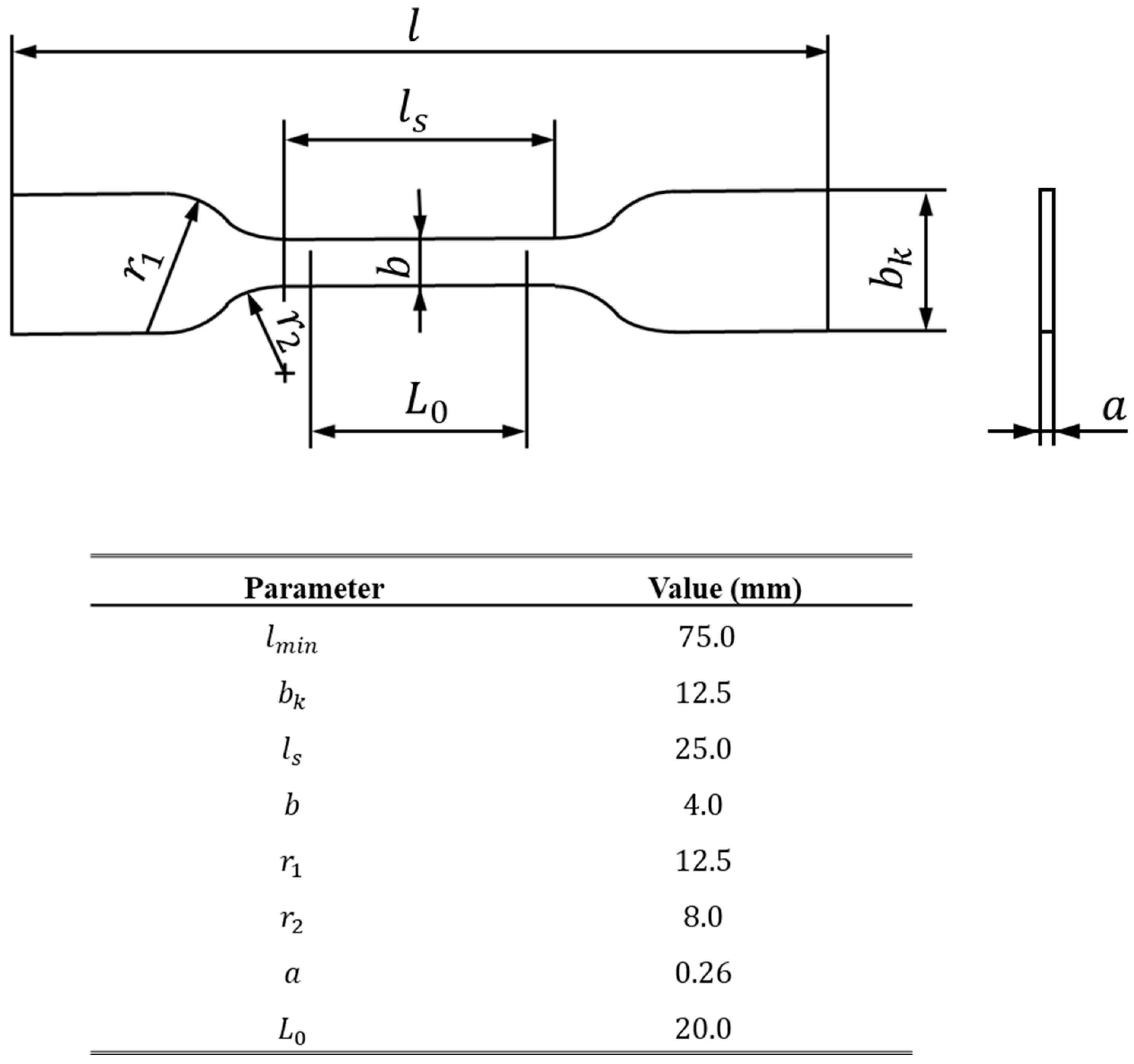


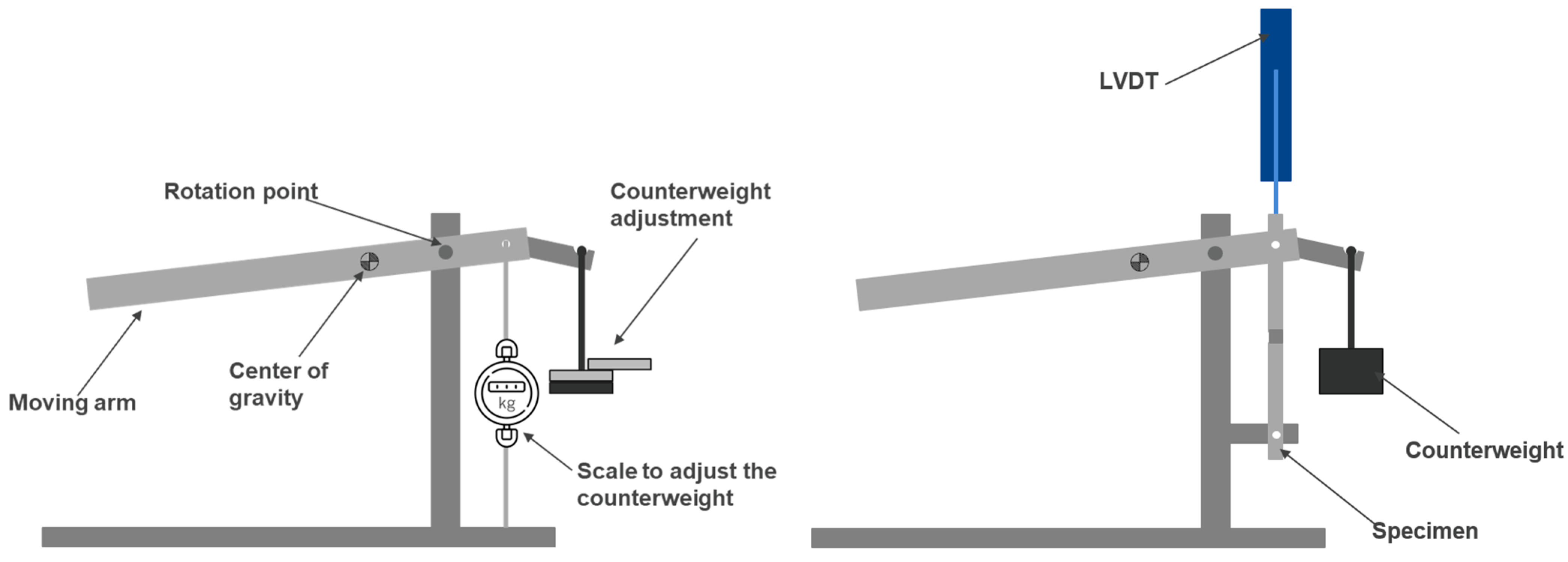



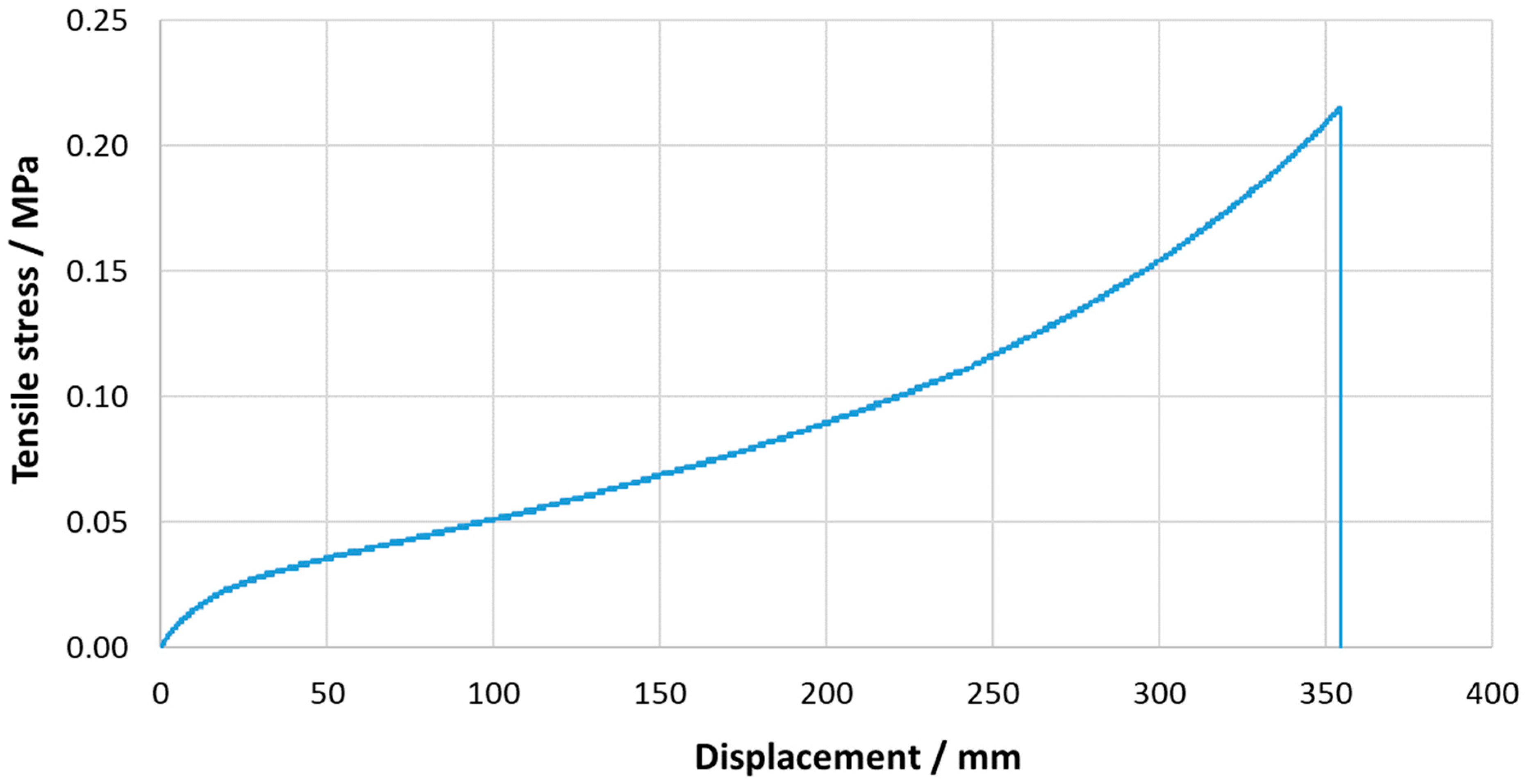



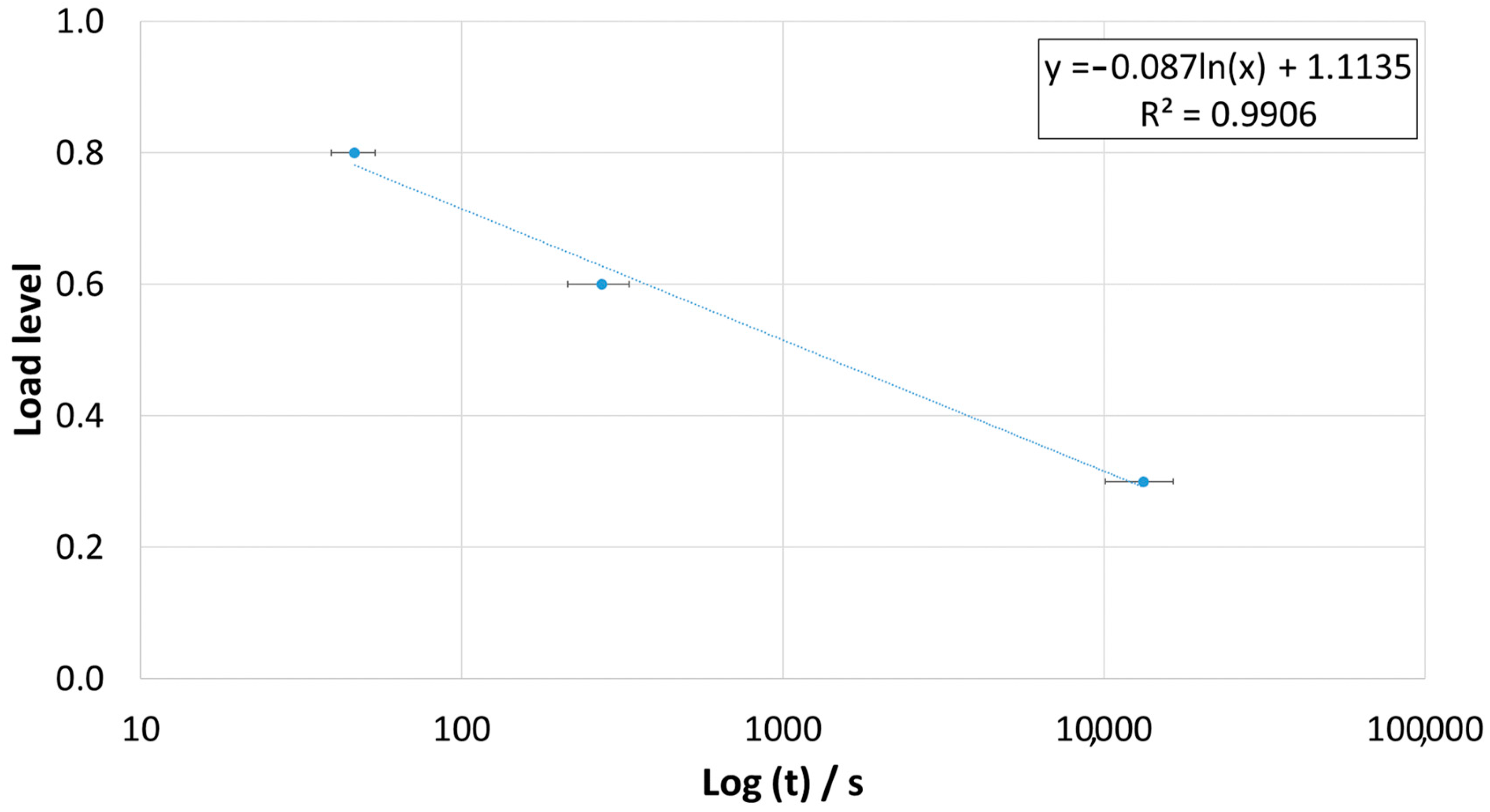
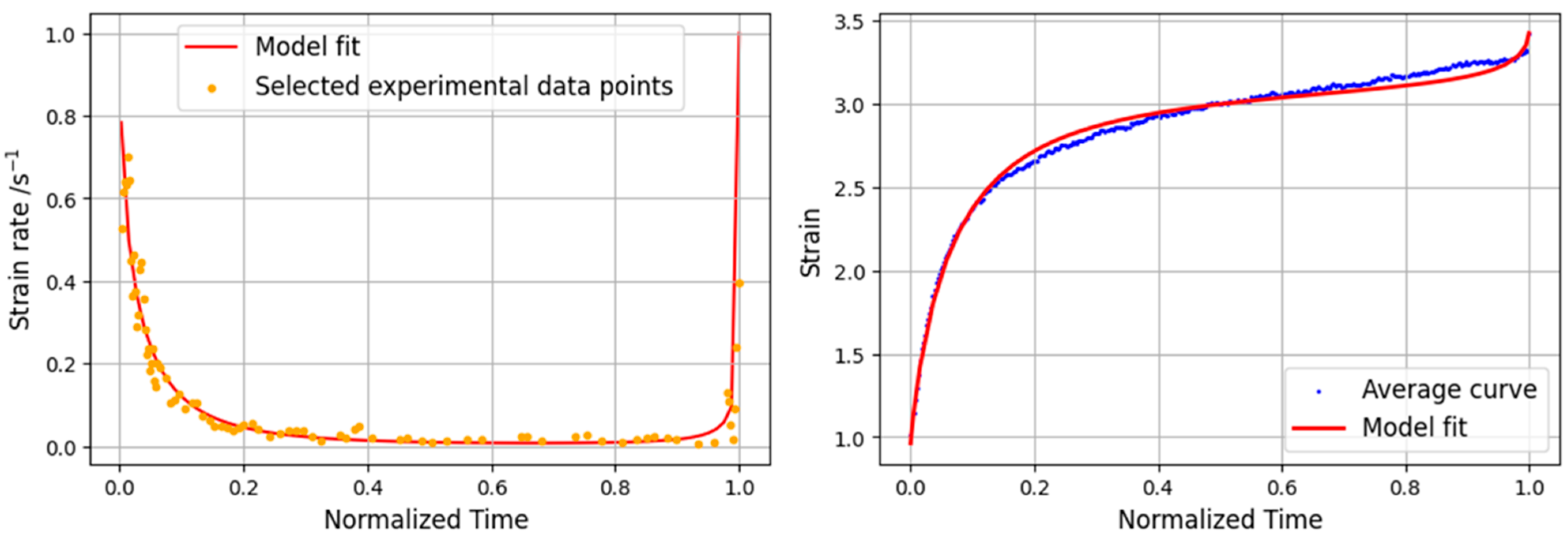
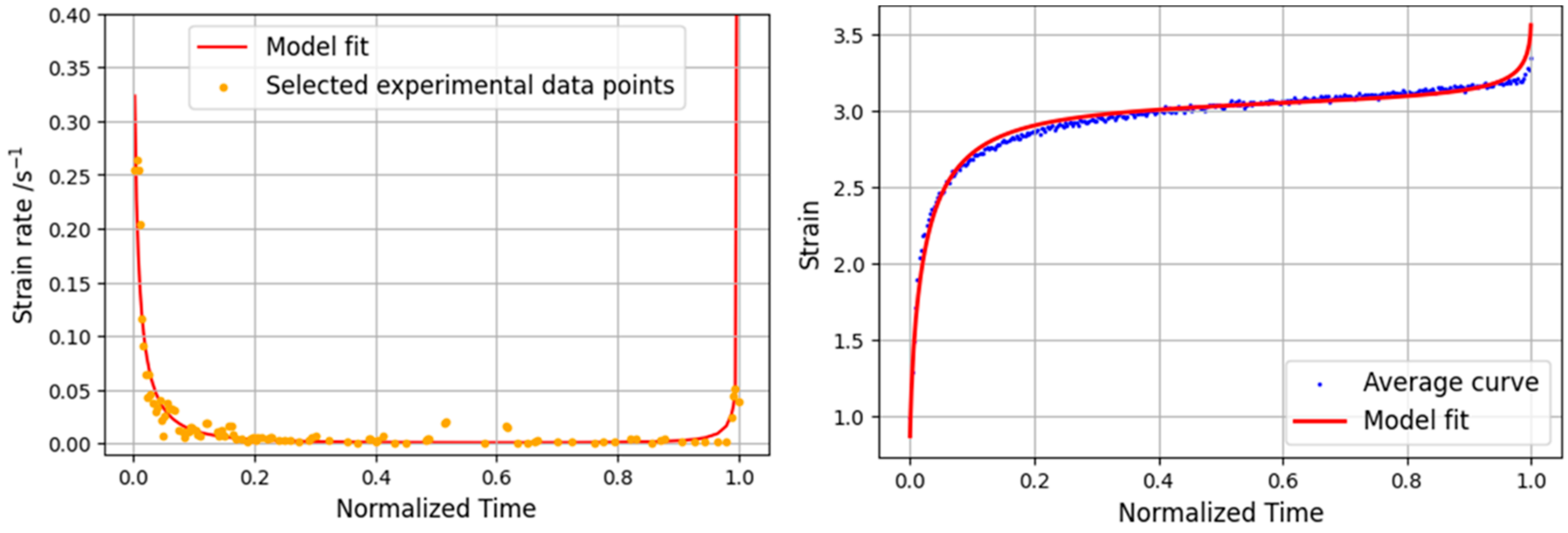
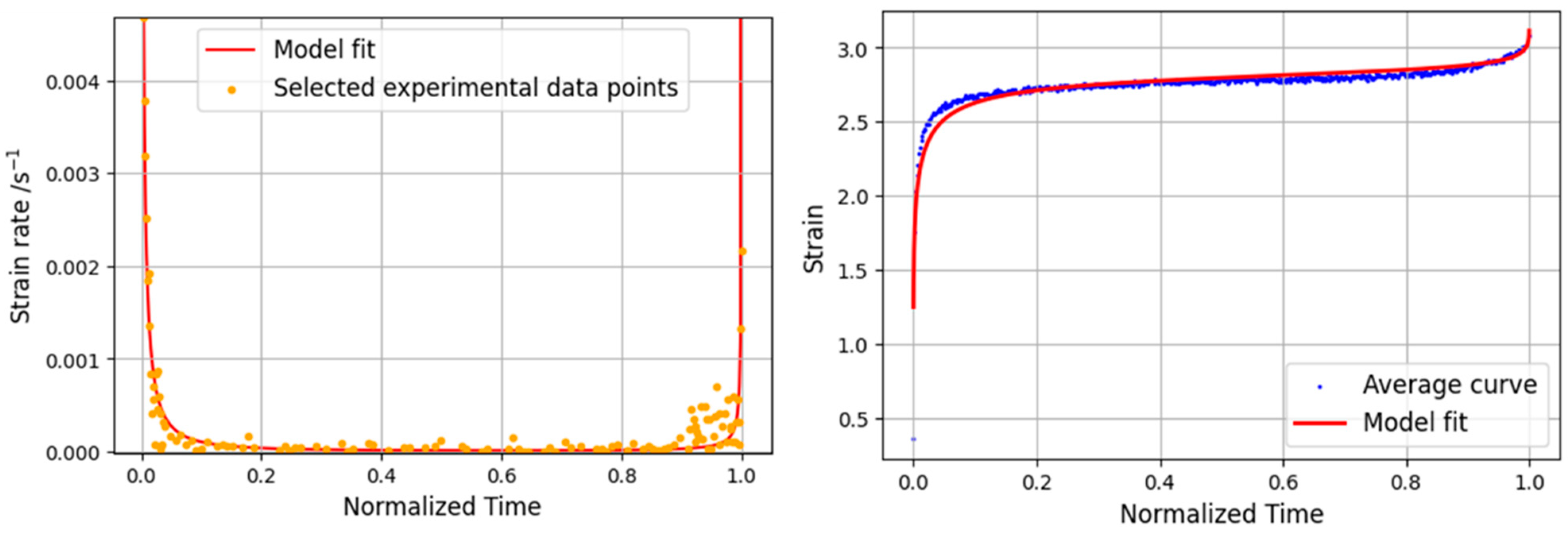

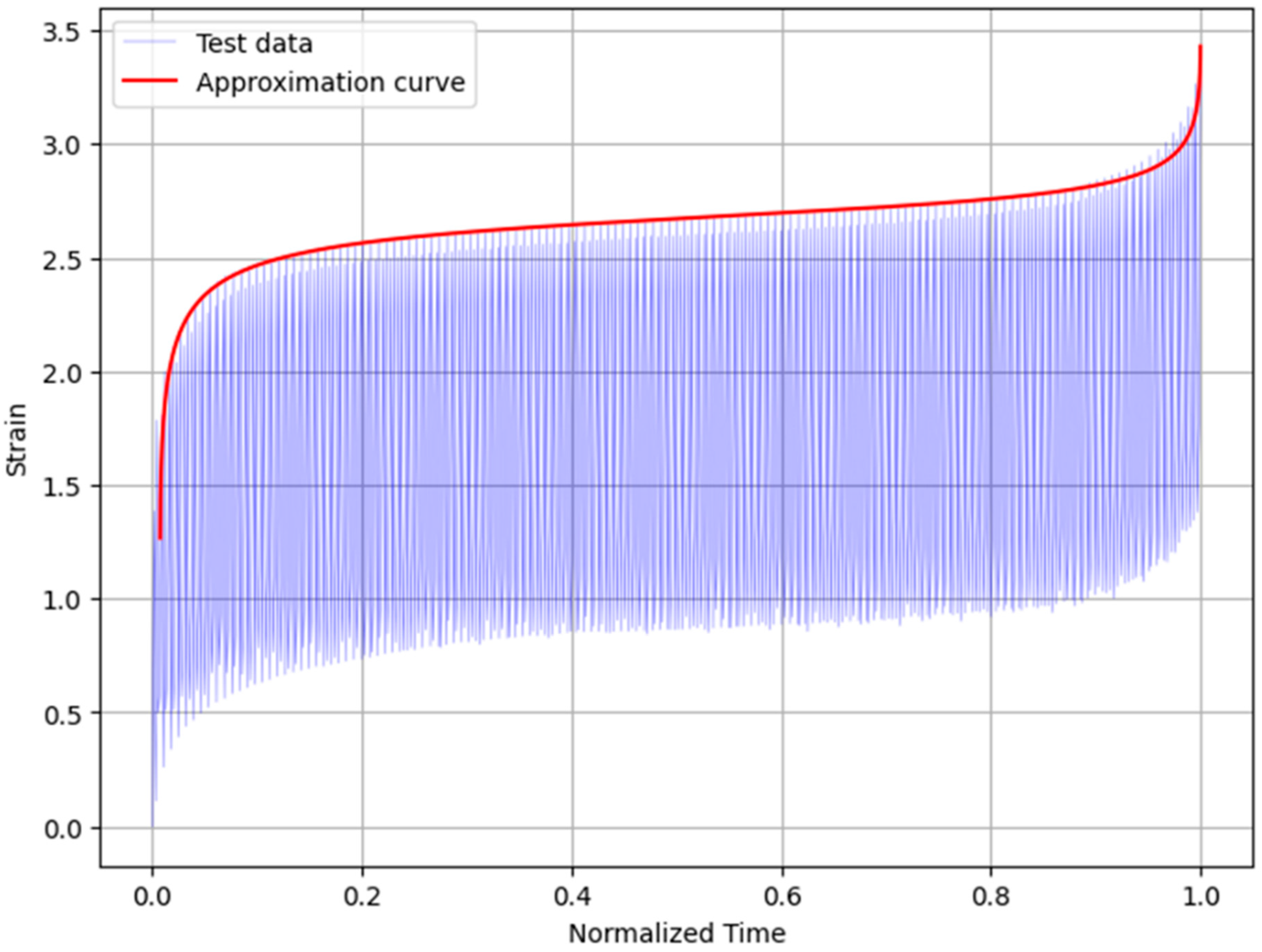
Disclaimer/Publisher’s Note: The statements, opinions and data contained in all publications are solely those of the individual author(s) and contributor(s) and not of MDPI and/or the editor(s). MDPI and/or the editor(s) disclaim responsibility for any injury to people or property resulting from any ideas, methods, instructions or products referred to in the content. |
© 2023 by the authors. Licensee MDPI, Basel, Switzerland. This article is an open access article distributed under the terms and conditions of the Creative Commons Attribution (CC BY) license (https://creativecommons.org/licenses/by/4.0/).
Share and Cite
Simões, B.D.; Fernandes, É.M.D.; Marques, E.A.S.; Carbas, R.J.C.; Maul, S.; Stihler, P.; Weißgraeber, P.; da Silva, L.F.M. An Exploratory Study on Determining and Modeling the Creep Behavior of an Acrylic Pressure-Sensitive Adhesive. Materials 2023, 16, 2029. https://doi.org/10.3390/ma16052029
Simões BD, Fernandes ÉMD, Marques EAS, Carbas RJC, Maul S, Stihler P, Weißgraeber P, da Silva LFM. An Exploratory Study on Determining and Modeling the Creep Behavior of an Acrylic Pressure-Sensitive Adhesive. Materials. 2023; 16(5):2029. https://doi.org/10.3390/ma16052029
Chicago/Turabian StyleSimões, Beatriz D., Élio M. D. Fernandes, Eduardo A. S. Marques, Ricardo J. C. Carbas, Steven Maul, Patrick Stihler, Philipp Weißgraeber, and Lucas F. M. da Silva. 2023. "An Exploratory Study on Determining and Modeling the Creep Behavior of an Acrylic Pressure-Sensitive Adhesive" Materials 16, no. 5: 2029. https://doi.org/10.3390/ma16052029





